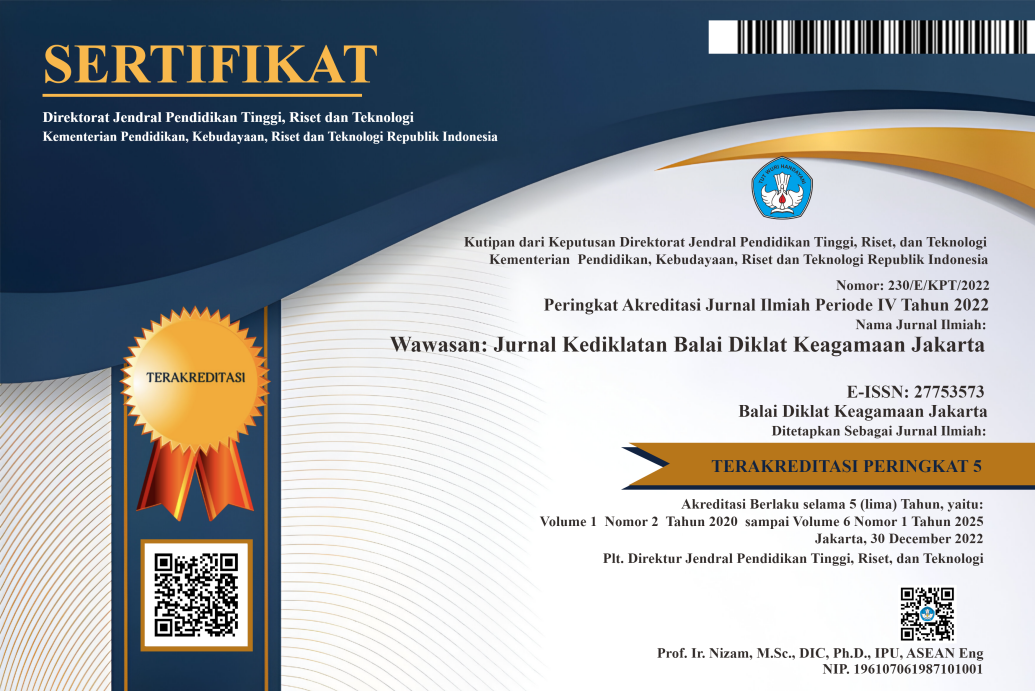EVALUASI FORMATIF DESAIN INSTRUKSIONAL DIKLAT JARAK JAUH PENELITIAN TINDAKAN KELAS
DOI:
https://doi.org/10.53800/wawasan.v1i2.36Keywords:
DJJ Online , evaluasi formati, Dick and Carey, field trial, ELLSAbstract
Classroom Action Research Online Training is one of Online Training (Diklat Jarak Jauh) organized by Jakarta Religion Training Office (BDK Jakarta). The training still has some weaknesses including low graduation rate and academic learning outcomes. It needs evaluation to formulate some revision in its instructional system. One of the important component should be evaluated is instructional design. This study explains formative evaluation results of the instructional design. The study was conducted to answer three questions, 1) Is the teaching material in accordance with the participants' wishes? 2). Is teaching material presented using the right strategy so that it is easy to learn? 3). Has the tutor service met the expectations of participants? The results of the study are expected to formulate recommendations for revision. Formative evaluations are conducted within the framework of Dick and Carey's instructional development model focuses on field trials level. The data was collected through surveys using ELL, activity logs, tutor records and recordings of participant’s conversations on social media. Survey results are processed using descriptive statistics and qualitative data processed using content analysis. The research concluded that teaching materials and teaching strategies are low scored. Based on the conclusion, it is recommended to change the structure curriculum to ensure that the teaching materials are more detailed, implement more diverse learning strategies and apply Web 3.0 as a base to determine media in accordance with the learning style of the digital community.
Downloads
References
Albu, R. D. (2014). A study about Web 3.0 based e-learning tools in electrical and electronics engineering. Journal of Electrical and Electronics Engineering, 7(1), 9–12.
Arkorful, V., & Abaidoo, N. (2015). The role of e-learning , the advantages and disadvantages of its adoption in Higher Education . International Journal of Instructional Technology and Distance Learning, 2(12), 397–410.
Bates, A. W. (Tony. (2015). Teaching in a Digital Age. In Quarterly Review of Distance Education (Vol. 16, Issue 4). Creative COmmons Attribution-NonCOmmercial 4.0.
Bawa, P. (2016). Retention in Online Courses: Exploring Issues and Solutions—A Literature Review. SAGE Open, 6(1). https://doi.org/10.1177/2158244015621777
BDK-Jakarta. (2012). Laporan Akhir Tahun Kediklatan BDK Jakarta.
Gall, M. D., Gall, J. P., & Borg, W. R. (2015). Applying Educational Research How to Read, DO and Use Research to Solve Problems of Practice (Seventh Ed). Pearson.
Horton, W. (2012). E-Learning by Design. In Journal of Chemical Information and Modeling (2nd ed., Vol. 53, Issue 9). Pfeiffer. https://doi.org/10.1017/CBO9781107415324.004
Hussain, F. (2012). E-LEARNING 3.0=E-LEARNING 2.0+WEB 3.0? IADIS International Conference on Cognition and Exploratory Learning in Digital Age, Celda, 11–18.
Isaias, P., Ifenthaler, D., Kinsshuk, & Samson, D. (2012). Toward Learning and Instruction in Web 3.0 Advance in Cognitive and Educational Psychology (M. J. Spector (ed.)). Springer. https://doi.org/10.1017/CBO9781107415324.004
Lal, M., & Rajiv. (2011). Web 3 . 0 in Education & Research. International Journal of Information Technology Bharati Vidyapeeth’s Instritute of Computer Application and Management, 3(2), 335–340.
Park, J.-H., & Choi, H. J. (2009). Factors Influencing Adult Learners’ Decision to Drop Out or Persist in Online Learning. Educational Technology & Society, 12(4), 207–217. https://0-search-proquest-com.cataleg.uoc.edu/docview/1287038599?accountid=15299
Sorensen, C., & Donovan, J. (2017). An examination of factors that impact the retention of online students at a for-profit university. Online Learning, 21(3), 206–221. https://doi.org/10.24059/olj.v21i3.935
Wang, Y. S., Wang, H. Y., & Shee, D. Y. (2007). Measuring e-learning systems success in an organizational context: Scale development and validation. Computers in Human Behavior, 23(4), 1792–1808. https://doi.org/10.1016/j.chb.2005.10.006
Wilging, P. A., & Johnson, S. D. (2004). Factors that influence students’ decision to dropout of online courses. Journal of Asynchronous Learning, 8(4), 115–127. https://doi.org/10.24059/olj.v13i3.1659
Downloads
Published
Issue
Section
License
Copyright (c) 2020 Wawasan: Jurnal Kediklatan Balai Diklat Keagamaan Jakarta

This work is licensed under a Creative Commons Attribution-NonCommercial-ShareAlike 4.0 International License.


















